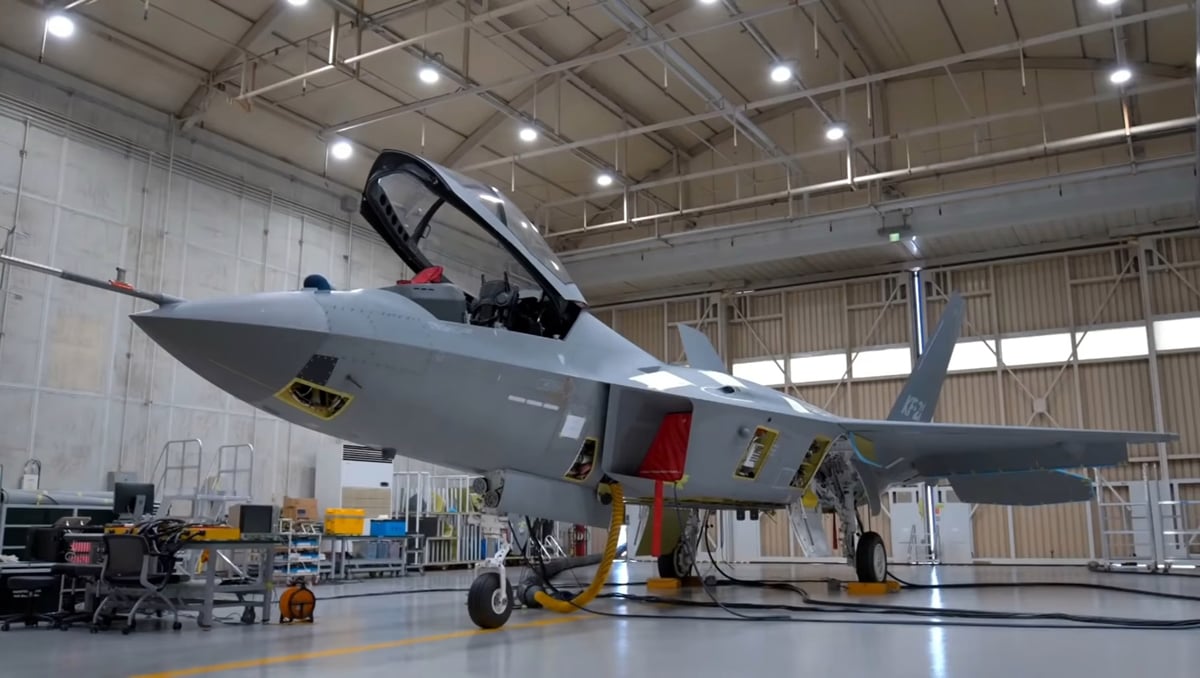Korea's New Hunting Hawk KF-21 Readies for First Flight
February 12, 2022
This year will likely prove critical for the Korea Aerospace Industries (KAI) KF-21 Boramae, Korea’s new indigenous fighter, as its manufacturer prepares for a maiden flight scheduled for July. The KF-21 is KAI’s most advanced aircraft program to date, and although the Korean Defense Acquisition Program Administration (DAPA) classes the KF-21 as a 4.5-generation fighter because it lacks internal weapons carriage, it reportedly plans a more stealthy variant.
Despite its lack of true low-observable capability, many analysts believe that the KF-21 will enjoy a very low frontal radar cross-section and good electronic warfare capabilities, ensuring a high level of survivability. It also will likely fly higher and faster than the F-35, while carrying a formidable weapons load, particularly for air-to-air missions.
The KF-21 Boramae—whose name derives from the historical term describing one-year-old hunting hawks specifically trained for traditional falconry—is the product of an extremely ambitious program that aims to produce an aircraft that will form the future backbone of the Republic of Korea Air Force (ROKAF) and, indeed, of the Indonesian air force (TNI-AU). The program involves a joint venture between South Korea and Indonesia, with an 80:20 split between Seoul and Jakarta.
In April 2021 the KF-21 prototype rolled out at the KAI factory in Sacheon, and the six flying prototypes—including two two-seat trainers, the first of them being aircraft number 4—and two non-flying test articles have undergone rigorous ground testing since then. Pilot evaluation and interior and exterior lighting ground tests took place using the third prototype.
Plans call for testing to last until about 2026, after which mass production of the KF-21 will begin. The program aims to deploy 40 aircraft by 2028 and 120 by 2032. The new fighter initially would replace South Korea's F-4Es and F-5Es and it could also eventually replace the ROKAF's fourth-generation F-16s and F-15Ks. The TNI-AU expects to take delivery of some 50 under current plans.
However, the program carries more than just military importance. In the past few years, KAI has developed and produced a series of indigenous aircraft designs, and the company—originally established as a joint venture of Samsung Aerospace, Daewoo Heavy Industries' aerospace division, and the Hyundai Space and Aircraft Company—has become an industrial powerhouse, making a major contribution to the national economy and providing high-value jobs for Korean workers, with innovative training schemes, apprenticeships, and opportunities for young engineering graduates.
Among its products, the KT-1 Woongbi turboprop-powered basic trainer and T/FA-50 Golden Eagle advanced training/light fighter aircraft have won significant export orders, and KAI hopes that the KF-21 will also become an important driver of exports and a creator of as many as 100,000 jobs when full-scale mass production begins. The program carries an estimated value of 5.9 trillion Korean won ($5.2 billion). Exports remain a possibility, as the aircraft promises to be technologically advanced, operationally capable, and inexpensive.
The KF-21 also promises to give Korea’s aerospace industry invaluable experience in a number of important new technologies. Original plans called for the KF-21 (then known as the KF-X) to incorporate some U.S. technologies, the transfer of which to Korea had been agreed when the ROKAF signed for 40 F-35As, known locally as the “Freedom Knight”. Four technology areas formed “core technologies” necessary for the development of the KF-21, namely the active electronically-scanned array (AESA) radar, the radio frequency (RF) jammer, the electro-optical targeting pod (EOTP), and the infrared search and track (IRST) system.
U.S. Congress subsequently deemed the technologies too sensitive for transfer, putting the whole KF-X program at risk. The Korean Agency for Defense Development (ADD) therefore conducted an in-depth feasibility study, eventually concluding that Korea itself could develop the technologies indigenously.
The most difficult and high-profile effort of the four probably centers on the development of a suitable AESA (active electronically scanned array) radar by Hanwha Systems with assistance from Israel's Elta Systems. Contrary to some reports, the new radar is not based on an existing Israeli radar, nor on Elta software, though the company has helped with “overseas aerial testing” in Israel using company equipment and aircraft. Elbit Systems is supplying the terrain-following/terrain-avoidance system to Hanwha. The partners claim an “89 percent localization rate” for the EASA radar.
Airborne testing has involved operating a test radar from the open rear ramp of a C-130 Hercules, as well as using a South African-registered Boeing 737-55S (ZS-TFJ), which has a KF-21 radome grafted onto its own nose. Development of the radar has reached completion after a decade of R&D effort and a three-year development program.
Hanwha is also developing the KF-21’s EOTP and nose-mounted IRST sensor, reportedly based on Leonardo's SkyWard system. South Korean company LIG Nex1 has begun work on a new integrated electronic warfare suite for the KF-21 with radar warning, radio frequency jamming, and chaff/flare systems.
One foreign-supplied system is the pilot’s ejection seat. The UK's Martin-Baker Aircraft began trials in February 2021 and has now finished testing. It will base ejection seat testing for the two-seat version of the aircraft on the ejection seat test results of the single-seat KF-21 and verify the results within the first half of next year.
Locally developed systems include the digital flight control computer, stores management computer, and embedded training unit, all under development by LIG Nex1. The Korean company also is developing the low-profile head-up display, which uses BAE Systems' waveguide-optics technology. Meanwhile, Hanwha Techwin will support locally assembled General Electric F414-400K engines from the U.S.
KAI expects to fly the prototype of its KF-21 Boramae multirole fighter this year.

www.ainonline.com






